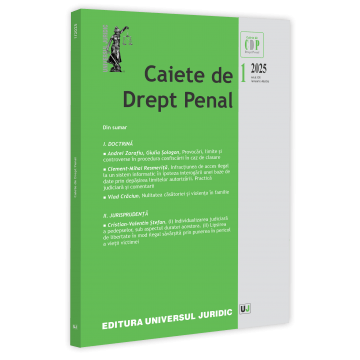(I) The judicial individualization of punishments, in terms of their duration (II) Unlawful deprivation of liberty committed by endangering the victim’s life
DOI:
https://doi.org/10.24193/CDP.2025.1.8Keywords:
judicial individualization of the punishment, illegal deprivation of libertyAbstract
I. The process of the judicial individualization of the punishment is not arbitrary. It is guided by clearly pre-established and well-defined rules. These rules refer to the finality of the punishment and its functions, on the one hand, as well as to the landmarks and criteria of judicial individualization, on the other hand. When it comes to landmarks, the seriousness of the offence is first taken into account and only then the dangerousness of the offender is taken into account. When it comes to criteria, they are all used, in a mandatory manner. All these rules guarantee that the established punishment has, by its nature and by its duration or amount, a just character.II. Within the aggravating circumstantial element regarding the commission of the offence of illegal deprivation of liberty by endangering the victim’s life, the mental position of the active subject is that of the exceeded intention (preterintention), namely: intention in relation to the deprivation of liberty and fault in relation to the endangerment of the victim’s life. If the mental position of the active subject is characterized by intention both in relation to the deprivation of liberty and in relation to the endangerment of the victim’s life, there is a concurrence between the offence of illegal deprivation of liberty in the simple version (or possibly in the aggravated version, but with the retention of possible other aggravating circumstantial elements, apart from the one regarding the endangerment of the victim’s life) and the offence of attempted murder.
(High Court of Cassation and Justice, Criminal Section, Decision no. 309/A/18.11.2024)

